Who and what is the ruling class?
Composition and divisions among capitalists

“We are all in this together.”
This is a verbatim quote said time and time again by such luminaries as Winston Churchill, Barack Obama, Donald Trump, Joe Biden, and the list goes on. It is a favorite of the ruling class, and yet they try to deny the existence of a ruling class altogether. This article explores why some people have more power to make important decisions that affect us all. It also explores who these people are and how they rule today. It will provide an analysis of the structural relationships that cement their rule: the market and the state.
Why is it that in every country in the world, some people have nearly all the wealth while most people are scraping to get by? As much as the ruling class clings to the mantra “we are all in this together,” if we look at the distribution of wealth, this claim is obviously false. In the United States, for example, the distribution of household wealth remains unevenly distributed. The top one percent owns 30.6 percent of the wealth, whereas the bottom 50 percent–a full half of the country–only owns 3.3 percent of the wealth.
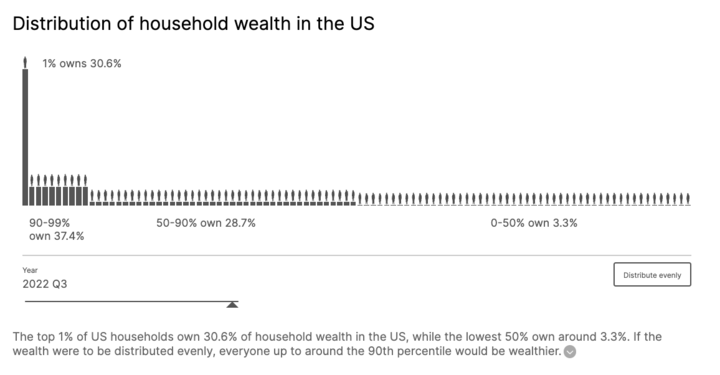
Clearly, this is not a great situation, but the justification provided by the ruling class and their ideological mouthpieces is that all boats float in this system and so some inequality must be accepted. If we go back in history about three decades to 1989, we see that the boats of the ruling class floated on 22.7 percent of the wealth and the bottom 50 percent floated on 3.8 percent–slightly more than present. This uneven distribution remains relatively the same except for moments of crisis during which the bottom 50 percent loses even more ground. For instance, in 2008 following the financial crisis, the bottom 50 percent claimed only 0.6 percent of the wealth, and while that figure has been steadily rising throughout a long and protracted recovery, it pales in comparison to the enormous wealth collected by the one percent over that same period. The middle earners, those who fall into the 50 to 90 percent have also lost ground during this same period, which, in part, accounts for the deepening political polarization experienced in the U.S.
When Marxists describe class, we are not speaking about the distribution of wealth exclusively, but the relationships between the classes that lead to this distribution. Nevertheless, these figures are a good proxy to illustrate the outcomes of these class relations. If wealth in the U.S. were to be distributed evenly, everyone below the top 10 percent would increase their wealth–that is, 90 percent of the population would be better off than they are under the present distribution. The bottom 50 percent, who currently own 3.3 percent of the wealth would suddenly own 50 percent of the wealth. That is a massive increase which would be transformative for people’s lives and for the relations between people in the U.S. However, importantly, these relations would have to be transformed through massive social upheaval in order to achieve a redistribution of this magnitude.
What allows for a ruling class?
Class has not always been a feature of human experience. There have been societies that can be best described as egalitarian. In these societies, individuals had a great amount of autonomy and they organized themselves through mutual collaboration. These were communities without fixed hierarchies of power. Although not exclusively, and with an enormous amount of variation, this is likely the way human beings organized themselves for most of history.
A society with permanent class divisions requires a sustained surplus, and without the ability to produce, maintain, and store surplus, class divisions have no material basis. Thus permanent class stratification emerges only when the ability to produce consistent surplus is achieved. The ruling class and the society that sustains it need to be fed. Societies that develop the ability to create and preserve enough food can also support a group of people who can spend time doing things other than hunting, gathering, or farming. This group comes to coordinate the production and storage of food and other resources, a role that separates the group from the other layers of society and establishes a class society.
In order for this surplus to be sustained by this ruling layer, the ruling class must reproduce itself and control that surplus across generations. In this sense, the emergence of class distinctions also accompanied gender-based oppression. Where there is a class-divided society, there has, for the most part, also been gender inequality.
It is not that agricultural technologies make inequality inevitable, but they make inequality possible, or at least much easier. Before agriculture, there may have been seasonal and or regional surpluses that meant that you could have some hierarchical structures within a given society – sometimes just seasonal – but in rare cases, enough to support a ruling class that passed down wealth from generation to generation. This is much easier if the group is sedentary so members don’t have to carry the extra food around for their rulers to eat.
What is a ruling class?
Ruling classes control and make decisions regarding the surplus resources generated by society. They are able to do so because they own or control the means for producing that surplus–the land, the infrastructure, etc. The ruling class needs technology to store surplus and to control its production in order to enforce its rule. They rely on ideology to justify that rule and force to back that up. The modern state emerges from these needs.
Importantly, just because a surplus allows for class stratification to happen doesn’t make it inevitable. Even once agriculture developed, it took around four thousand years before we saw class societies with states. Despite this, class-divided societies have become ubiquitous.
There was much resistance to establishing these societies along the way and that resistance, of course, continues to exist. Further, establishing a class society was difficult for both social and physical reasons. Sedentary societies were more prone to disease, and also had less diversity of resources to fall back on in times of bad harvests. But once we have planted seeds in the ground – we want to reap what we sow, and that invested labor would have compelled farmer societies to stay put. In addition, the force and/or ideology used to impose rule internally may have given these societies an advantage to conquer and or control those around them.
The fact is that it happened, and since then we have had various forms of class societies still with enormous variation including slave, feudal, and today various formations of capitalist relations. In some of these societies, the ruling class’ economic control of the surplus was explicit. For example, in slave societies, the surplus created by slaves is taken from them under conditions of force. In feudal societies peasants worked the land and produced enough food for their own survival; however, the nobility, who controlled the land, directly requisitioned any “extra” crops. In both these instances, surplus is directly extracted from the labor of another. There have been all sorts of variations of this design, but the real innovation was capitalism.
In capitalism, the process of extracting surplus from workers is more opaque. We are told that we are paid a fair day’s pay for a fair day’s work, but the wage we receive is not based on how much value we produce. Instead, wages are determined by what it costs to keep an average person like you and your family alive. This amount is far less than the value we produce, and since the capitalist only wishes to part with the portion of profit that is absolutely necessary, wages are kept as low as possible.
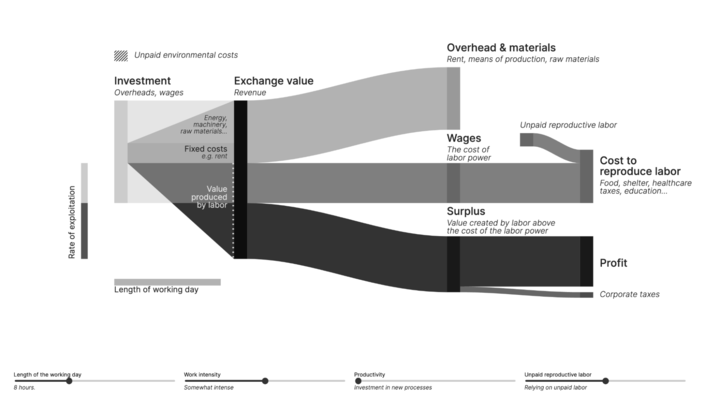
In Marxist terms, this economic transaction is called the Labor Theory of Value. Capitalists invest wealth into the production of things in order to create profit. They expect to put a certain amount of money into the production of things and receive a greater amount on the other side.
They Rule
When I created TheyRule.net to educate people about the linkages between ruling-class players, I realized that the indefinite pronoun “they” allowed for some misinterpretations. One is that corporate conspiracy cements the rule of the elite.

Certainly, corporations that are ostensibly competing with one another but connected through mutual directors give the impression of conspiracy! Despite this, It is notoriously hard to prove any price-fixing or other collusion, which is not to say it doesn’t exist as This American Life made clear. In today’s post-QAnon world, I am more wary than ever about insinuating that a conspiracy exists where I can’t demonstrate it. In earlier iterations of They Rule, I let people save maps with titles and annotations, but in the newly released version, I restricted the ability to annotate saved maps to minimize unfounded conspiracies being spread through the site. Corporate conspiracies, though no doubt they exist, are not the story I want to focus on.
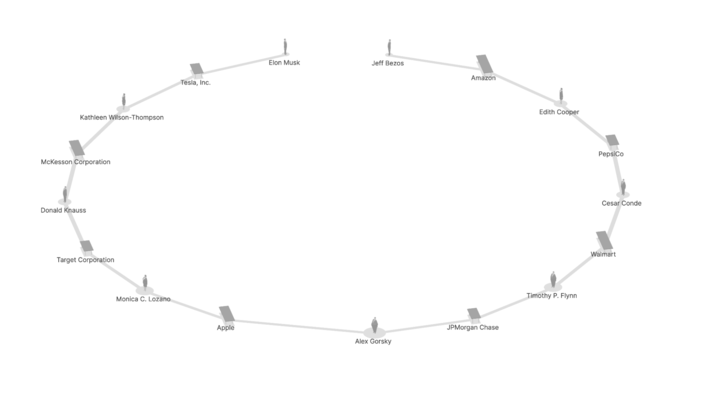
From the beginning, I have seen They Rule as a cartoonish “glimpse of some of the relationships of the U.S. ruling class.” It is not an exhaustive view of the class; rather, it is a small sample of it–a demonstration of its existence. This is the message I would like to convey with They Rule: there is a ruling class. It is the core claim of many Left traditions, such as the sociology developed by C Wright Mills and continued by William Domhoff who collates empirical evidence that there is a “power elite,” and Marxist traditions, which claim that class struggle is the key to understanding history and shaping our future.
In 2001, when I first began the They Rule project, the only class regularly discussed in polite circles was the “middle class”– a contested term that in some definitions consists of 96% of the population. Class was not a dominant lens for understanding society. They Rule was then meant to contest that absence by showing that a ruling class exists and that we can point to it, and visualize it.
Since the Great Recession of 2008, Americans’ perceptions of class have been shifting and more people consider themselves working class. The Occupy movement of 2011 and the slogan “We are the 99 percent” brought the language of class struggle back into public discourse. By 2015, Obama was using middle class as more of an aspirational term, and Bernie Sanders’ 2016 and 2020 presidential campaigns talked openly about the conflict between the billionaire class and the working class.
But, the Left is not the only group to re-engage with the idea that society is made up of opposing forces–a working class and a ruling class. The U.S. right has also started to claim these categories. The wealthy Republican senator, Josh Hawley, son of a banker, claims that his party is a “working class party now” and he is not alone. Following Trump’s lead, many GOP leaders see appealing to the working class as the best way forward for their party. Continuing in that vein, some on the far right shifted their rhetoric about a ‘liberal elite’ to include the label of ‘ruling class.’ For example, Tucker Carlson, once the most-watched cable news host, tweeted, “The ruling class has a new message on inflation: it may be painful, but it’s going to be good for you.” But, the Right’s definitions of class are not the same as the Left’s definitions. No one should be confused.
Other Carlson tweets make this difference clear: “Our ruling class prefers immigrants to Americans. Who are they more worried about those here illegally or citizens?” and “Donald Trump is and has always been a living indictment of the people who run this country. That was true eight years ago when Trump came out of nowhere to win the presidency and it’s every bit as true right now. Our ruling class is disgusting.” For Carlson, the ruling class is pro-immigrant and anti-Trump, a force aligned with the mythic coastal elite.
The Right’s use of the category of working class is equally manipulated. They use it as a thinly veiled synonym for the white working class. Carlson again: “Before deciding he didn’t really care, Obama once noted that low-skilled immigration hurts the working class.” For Carlson, immigrants are not part of the working class. And as he points out this is often true for the Democrats too. The working class, when employed by the right, tends to be a whitewashed category.
Without a doubt, you could construct maps using They Rule to tell a selective story about the ruling class. The far-right could attempt to create maps with antisemitic tropes; however, a holistic view of the data does not support this conclusion. For example, the most common given name of a director in 2001 and 2021 was John, and the top five family names common across 2001 and 2021 include, Smith, Johnson, and Brown. These family names are most often attributed to individuals of English descent.
Reality does not map onto Carlson’s claims about the ruling class. Nevertheless, if you traverse the connections in They Rule to the conservative think tanks and Republican administrations you find considerable interlocks.
There is a ruling class in the U.S., but it is not as the right imagines it to be.
Perhaps unsurprisingly, the first thing that stands out is that the ruling class is comprised of mostly older, white, men. This is changing. In 2001, only 13 percent of the directors of the 100 companies in They Rule were women, by 2021 that number had more than doubled to 31 percent. According to research by Institutional Shareholder Services, Inc. (ISS), the percentage of board seats held by racially/ethnically diverse directors in the S&P 500 increased from 13 percent in 2013 to 23 percent in 2022.
These modest changes are not the signs of progressive political leadership, rather this is a reflection of changes that have been won through struggle in society at large, and the corporate elite are catching up, sometimes because of legislation.
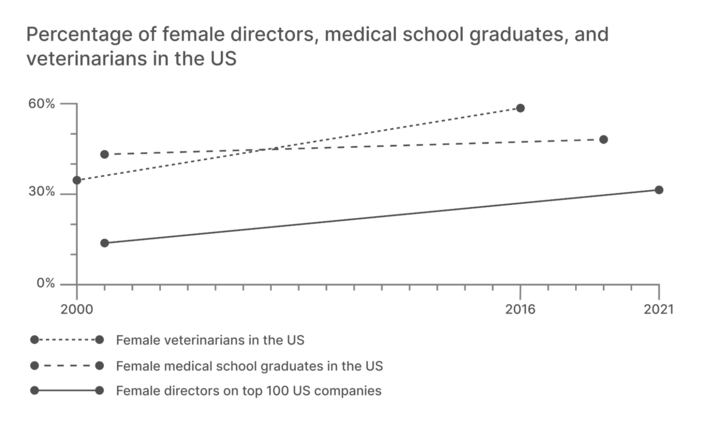
Demographics
The 2020 Black Lives Matter demonstrations in response to the racist police killing of George Floyd precipitated an abrupt rise in corporate board diversity according to a blog post on the Harvard Law School Forum on Corporate Governance. “As the ISS board diversity data shows, there has been visible progress since 2020 in the number of racially/ethnically diverse directors on U.S. company boards, and this uptick in diversity and inclusion initiatives has been dubbed by some ‘The George Floyd Effect’.”
The increase in diversity does not suggest that those directors who are in under-represented groups don’t face any oppression. Consider this auto-biographical story told by Dambisa Moyo in her book How Boards Work:
In May 2010, I joined a dozen board colleagues onstage at the annual general meeting of a board on which I served. During the question-and-answer portion of the proceedings, a shareholder in the audience posed a question to the chairman of our board. The shareholder asked, while gesturing at me, “What are the credentials of that statutory board member that she would be allowed to sit on the company’s board?” I was, at the time, the only woman and the only visible minority serving on the board.
Moyo has a BS in chemistry, an MBA, an MPA, and a DPhil, which makes her more qualified than almost anyone else included in the They Rule data set. Despite being a Baroness and married to a billionaire, Moyo’s story shows that directors from oppressed groups may be part of the ruling class, but they still face much of the bigotry of our society.
Singling out Moyo to question her qualifications was racist and sexist, but the general question of what qualifies people to be in this slice of the ruling class (as well as the ruling class in general) is worth considering.
A Masters’ in Business Administration (MBA) is the most common qualification for the directors included in the They Rule data set; at least 35 percent of the 2021 cohort hold one. 19 percent of directors attended Harvard Business School (HBS), 12 percent attended Harvard University, 10 percent attended Stanford University and 8 percent attended The Wharton School [the business school at the University of Pennsylvania]. These prestigious college MBA programs are explicitly training world leaders. Perhaps surprisingly, the missions of all these programs place less emphasis on the specifics of finance, accounting, or particular sectoral acumen, and more emphasis on developing ethical leadership qualities.
These universities have succeeded in replenishing the elite with their stock, but what can we say about the results of their leadership? Amongst the elite themselves this is up for debate. I opened with a quote from Klaus Schwab, the Founder of the World Economic Forum (WEF) who points to the world’s problems including climate change and the reemergence of infectious diseases, and concludes that “Our institutions and their leadership are no longer fit for purpose.” This would be a remarkable statement, and we might think it an outlier position; nevertheless, it represents at least a public-facing ideological shift amongst a section of the class.
Environment, Social, and Governance (ESG)
In August 2019, the Business Roundtable, an association of U.S.-based CEOs, issued a new Statement on the Purpose of a Corporation, which confirms that they “believe the free-market system is [still] the best means of generating good jobs, a strong and sustainable economy, innovation, a healthy environment and economic opportunity for all,” but also specifically commits to companies fostering “diversity and inclusion, dignity and respect.” “[d]ealing fairly and ethically with our suppliers,” and “[s]upporting the communities in which we work. We respect the people in our communities and protect the environment by embracing sustainable practices across our businesses.”
Pronouncing that corporations should care about more than just their shareholders might not seem like a big deal, but in a press release for the statement the Business Roundtable outlined its significance:
Since 1978, Business Roundtable has periodically issued Principles of Corporate Governance. Each version of the document issued since 1997 has endorsed principles of shareholder primacy – that corporations exist principally to serve shareholders. With today’s announcement, the new Statement supersedes previous statements and outlines a modern standard for corporate responsibility.
Marc Benioff, co-founder, chairperson, and co-CEO of Salesforce, put the shift in thinking more dramatically:
Capitalism as we have known it is dead. This obsession we have with maximizing profits for shareholders alone has led to incredible inequality and a planetary emergency. When we serve all stakeholders, business is the greatest platform for change.
The mechanisms for encouraging and enforcing the boardroom focus on shareholder interests or wider stakeholder and environmental interests are shifting too. The rise of institutional investors – large investment management companies like Blackrock which manage huge pension and 401k funds for millions of people have promoted Environmental, Social, and Governance (ESG) criteria to receive or maintain their investment.
Critics of ESG
ESG has been a target of conservatives, and not just rhetorically. In April 2022, Judicial Watch, a right-wing advocacy group, had success with its lawsuit against a California law requiring diversity on corporate boards. And Republican politicians have made their fight against ESG a prominent feature of their war on what they call “woke capitalism”.
The idea that capitalism is the best framework for addressing environmental and social challenges like climate change or racism (ie “woke” issues) is also coming into question by those who would like to see these issues actually addressed. The benchmarks for evaluating the ESG performance of corporations are questionable at a minimum. The New York Times published an opinion piece by Hans Taparia, a clinical associate professor at the New York University Stern School of Business, claiming that ESG is a sham:
McDonald’s, for instance, was given an upgrade of its E.S.G. rating last year by MSCI [Morgan Stanley Capital International]… [b]ut greenhouse gas emissions from the operations and supply chain of McDonald’s, which is one of the world’s largest buyers of beef, grew by 16 percent from 2015 to 2020.
Perhaps the most publicly damning critic of the effectiveness of the ESG investment strategy is Tariq Fancy, the former chief investment officer for sustainable investing at BlackRock who questions the basic premise of ESG:
The ESG story is sold as an opiate to the masses. It lulls everyone from investors to activists into believing that more responsible companies also consistently perform better financially. In practice, ESG information has limited use in most investment processes. This is due to a combination of ambiguous data and inconsistent standards, short time-horizons for most investment strategies and the uncomfortable reality that being responsible usually isn’t profitable (emphasis added).
Liberal and conservative critics of ESG often come to a similar conclusion: It would be more effective to keep political decisions in the realm of the state. Former presidential candidate in the 2024 GOP primary Vivek Ramaswamy, author of “Woke, Inc.” [sic], and conservative critic of ESG, wrote in the Economist in 2022 that his
greatest concern of all with stakeholder capitalism, no matter how it’s defined: its proponents are eager to strengthen the link between democracy and capitalism at a time when we should instead assiduously disentangle one from the other.
The more liberal Hans Taparia says, “Policymakers — specifically, the Securities and Exchange Commission — can and should play a role in designing and enforcing an E.S.G. rating system worthy of the name.” And Fancy agrees, “The central tenet of ESG investing—that more responsible companies are more profitable—has a better chance of becoming true if the state regulates critical areas and penalises bad behaviour.”
The conclusions sound similar, but we should be skeptical, especially with regard to the conservative side of the argument. Ramaswamy, just raised funds for an “anti-ESG” Exchange Traded Fund (ETF) to counter BlackRock’s ESG strategy. Far from being neutral on political questions – they actively criticize corporations for progressive actions. And remember, when the state does intervene to impose ESG criteria like corporate board diversity requirements, conservatives are quick to sue the state on constitutional grounds. The reality is that although both the liberal and conservative capitalists endorse a separation of the state and the market the two are entwined.
When we consider the ruling class as a whole, with political and corporate leaders, we are really discussing a division of labor in decision-making. They are debating about the best way to distribute those responsibilities. The closer we look, the more arbitrary that division appears to be. You can not “disentangle” the market from the state. You cannot separate politics from the economy.
Political Economy
The question of where to draw the line between decisions made by the state and those made in the competitive context of the market was a chief concern of twentieth-century economic theorists. The leading critique of centralized economic planning by the state was written by the Austrian social and political theorist Friedrich Hayek. He argued, in a debate known as the economic calculation problem, that economic planners would never have enough information to plan an entire economy effectively. One of his main intellectual adversaries (they were on personally friendly terms) was John Maynard Keynes, who argued that given the fluctuations of capitalist economies from recessions to booms, government intervention and some degree of planning would be necessary to stabilize the system.
Both Hayek and Keynes agreed that there needed to be a regulatory framework that allowed markets to exist. And although Hayek was very critical of a planned economy, he was open to the state providing some social support if needed, which may be surprising given the extreme anti-state positions of his contemporary adherents. Nicholas Wapshott reveals this in his book Keynes Hayek: The Clash that Defined Modern Economics (2011). Hayek believed that the state may have a moral duty to step in and that was admissible so long as the spirit of free enterprise was not compromised. Indeed, Hayek conceded, “There can be no doubt that some minimum of food, shelter, and clothing, sufficient to preserve health and the capacity to work, can be assured to everybody.” Hayek goes on to affirm:
Where, as in the case of sickness and accident, neither the desire to avoid such calamities nor the efforts to overcome their consequences are as a rule weakened by the provision of assistance—where, in short, we deal with genuinely insurable risks—the case for the state’s helping to organize a comprehensive’ system of social insurance is very strong.
Hayek sounds like someone advocating for Medicare for All.
Wapshott provides Keyne’s response to this admission that the state has some role to play in planning to meet human needs. Keynes writes:
I come to what is really my only serious criticism. You admit here and there that it is a question of knowing where to draw the line. You agree that the line has to be drawn somewhere; and that the logical extreme is not possible. But you give us no guidance whatever as to where to draw it. It is true that you and I would probably draw it in different places.
The debate about state economic intervention continues to play out today with little agreement over where the line between government and corporate authority lies. Moreover, this line is drawn differently across geopolitical locations and across time. During my early childhood in Aotearoa/New Zealand, for example, the state-owned and managed forestry, air travel, telecommunications, and the post office. The 1984 Labour government shifted or sold all of this into either corporate partnerships or completely privatized enterprises. These actions were justified by the argument that competition would be better at managing these areas of the economy than the state.
The shift was dramatic and its results were life-altering. If we look at an overall indicator of public well-being like child poverty, we can see a devastating decline in living standards. Child poverty doubled from 14 percent in 1982 to 28 percent in 1996. This pattern is not unique to New Zealand. It occurred across the world as countries with robust social welfare systems and state-controlled enterprises for much of the twentieth Century faced economic crises in the 1970s. The Keynesian promise that state intervention could keep the worst excesses of capitalist recessions within reasonable limits.
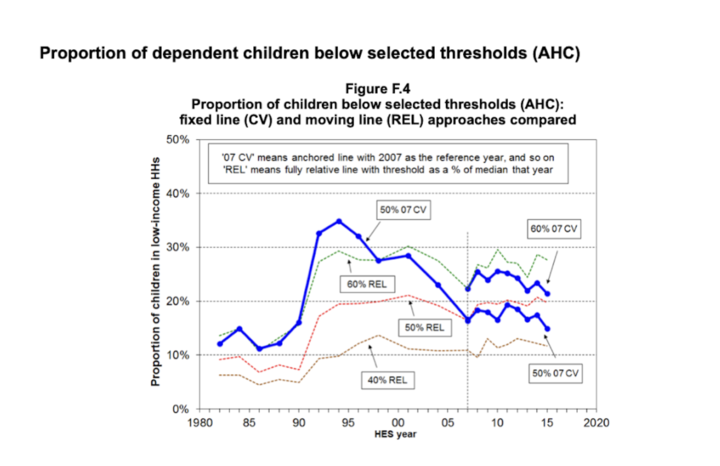
The response across the world was a shift to what became known as neo-liberalism and the ideas of Hayek gained greater credibility amongst the ruling class. Hayek won the Nobel Prize for Economic Science in 1974. In the U.S., although it never had a large social welfare system and limited state enterprise beyond the military, these changes began under the Carter Administration with the deregulation of the airline industry, continued through the Reagan Administration with trickle-down “Reaganomics,” and were realized under the Clinton Administration who carried out his promises to “end welfare as we know it.”
Sixteen years after the onset of the Great Recession, which was characterized as a protracted crisis with slow and unstable recovery, COVID-19 brought the global economy to a sudden halt. Although an official economic downturn beyond the initial shut-down periods was avoided (for now), the question of state economic intervention is back on the table. Worsening environmental conditions and increasing inequality, are driving the resurgence of Left Keynesian demands like the Green New Deal and Medicare For All. However, the ruling elite, those reflected in the They Rule data set, do not agree on how and when it is appropriate for the state to intervene. What this demonstrates, in addition to some capitalists’ seemingly irrational short-sightedness, is that the ruling class is not a monolith. Though they share interests, they have different positions regarding how those ideas should be carried out.
Featured image credit: RawPixel; modified by Tempest.
Opinions expressed in signed articles do not necessarily represent the views of the editors or the Tempest Collective. For more information, see “About Tempest Collective.”
Categories
We want to hear what you think. Contact us at editors@tempestmag.org. And if you've enjoyed what you've read, please consider donating to support our work:
DonateJosh On View All
Josh On is a socialist living and working as a designer in San Francisco. He made the website TheyRule.net, which visualizes the top 100 US companies and their interlocking boards of directors.
